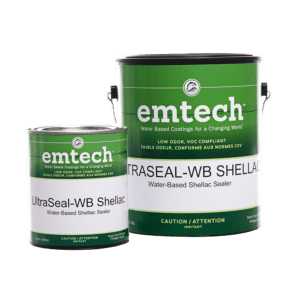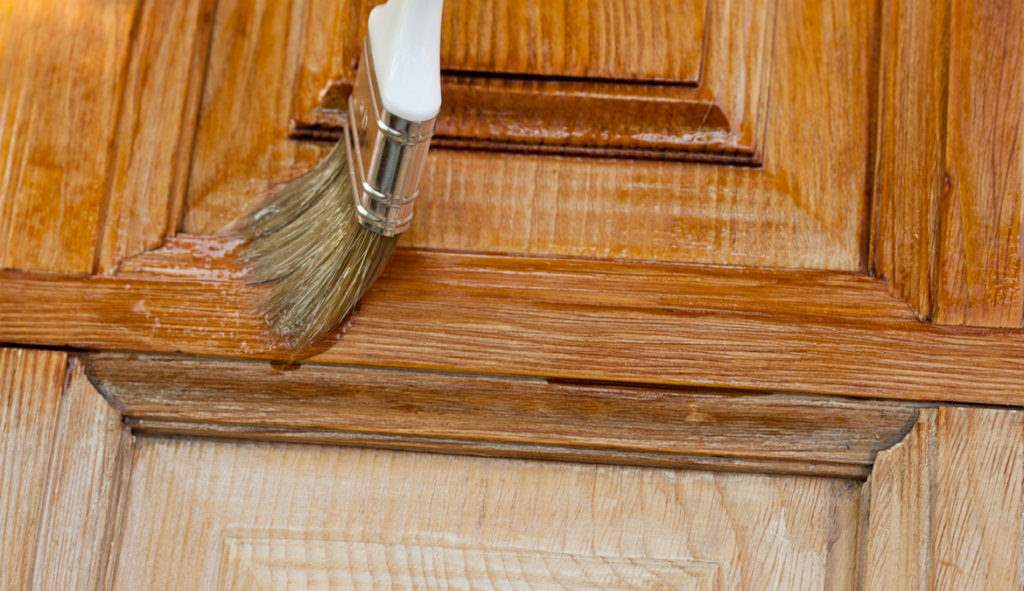
Last week we covered Step 1 (surface preparation) of my troubleshooting “cheat sheet” to help you quickly identify and avoid most finishing problems.
(Thank you to Vern W., Lawrence M., Joe K., Michael A., and Bill K. for your blog comments and kind words.)
Today, we’ll move on to Step 2: Stain and Topcoat Compatibility.
Tips for Using Water-Based Clearcoats with Solvent-Base Stain or Topcoats
- Yes – All EMTECH brand water-based finishes can be applied over semi or fully cured solvent/oil-based stains and topcoats. I get this question regularly when a customer is switching to a water-based finish—and it’s the easiest to answer!
- If you are refinishing a piece that is finished with a solvent-based coating it is important to inspect the adhesion and film formation quality of the old finish that is being restored. If the original coating shows any type of adhesion failure or surface defects that cannot be sanded level, then the old finish will need to be mechanically or chemically stripped down to the substrate.
- If the old finish shows good adhesion to the substrate and there are no major defects visible (repairing defects is a completely different side-bar topic) then you can proceed with cleaning the surface to be refinished with a mild, alkaline cleaner to remove surface dirt, grime and contamination, followed with a careful but thorough wipe-down with a solution of water and denatured alcohol mixed 1:1. This wipe-down will remove any residue left by the initial cleaning process and will help to neutralize any free alkalinity that may be left on the surface.
- The next step is to lightly fine sand the existing finish with the right sandpaper grit schedule. I cannot stress enough that you DO NOT want to be too aggressive with the grit size of the sandpaper being used. Aggressive grits can leave deep scratches that can telegraph up through the new finish, so for surfaces that only need a light scuff sanding I recommend 400-grit aluminum oxide sandpaper as the ‘go to’ grit. Some grades of 320-grit are OK, but do not go any more aggressive than that. Water-based/waterborne coatings have very good adhesion qualities, so you are not sanding to create “tooth or bonding” scratch – you are sanding to level the surface of any defects that may telegraph up into the new finish.
- It is OK to apply water-based sealers or topcoats over a solvent/oil-based wood stain. You must keep in mind that many consumer and commercial grade solvent stains contain a percentage of mineral spirits – and this is the culprit that causes most of the failures between the WB finish and the solvent stain. It is critical that you follow the dry-time schedule as written by the stain manufacturer, which tends to be between 12-18 hours. Once the prescribed dry time has lapsed it is critical that you remove the oily residue that resides on the surface of the stain in question. That oil is mineral spirits, or parts-thereof – and if it is not removed it will cause a blush, haze or powdering effect when the water-based clear coat begins to dry on top of it. It can also cause poor film formation, i.e. fisheyes in the wet film formation of the WB as it is leveling. If you see this effect, you need to STOP and start over. So how do we beat this contamination problem – EASY – Wipe the dried solvent-stain with our go-to water and denatured alcohol blend (1:1) to remove any of the greasy diluent that is residing on the surface of the wood stain BEFORE you begin the sealer or clear coat application process. I think this part of the procedure is starting to sound familiar, yes?

EMTECH USH3000 UltraSeal-WB Shellac Sealer
- The use of a dewaxed shellac sealer as a barrier coat is sometimes required. Substrates that are highly contaminated with oils or sealants — or are stained with a high-solvent content — should be treated with a light application of fresh, one-pound cut dewaxed shellac in the color grade of your choosing. A great option is our USH3000-UltraSeal WB Shellac Sealer and Barrier Coat, as it is made from natural dewaxed shellac flake and imparts a warm amber color tone in a water-reduced format. Yes, you can use Zinsser SealCoat® as a barrier coat, but ensure that you reduce it with alcohol, but it should not be used underneath any of our Emtech® pigmented lacquers or primers. We’ll be getting to surface preparation for a painted surface in our next installment.
As we talked about in Step 1, starting with a sound, clean, contamination-free surface is the first way to achieve stain and topcoat compatibility–and ensure a successful final finish. And when you follow the above tips, using water-based finishes over solvent-based stains can bring you beautiful, and durable, results.
I hope these simple tips help explain how your stain and topcoat can “play nice,” regardless if they are oil/solvent-based or water-based.
Keep an eye out for the next item on my list: “Step 3: Primer and Pigmented Topcoat Compatibility.”
Until then, do you have any stain/topcoat advice of your own? Or have any questions about stain and topcoat compatibility? Please share your thoughts or read what others are saying in the comments section below.



Not a question directly related to the current discussion, but wondering when there may be more of a roll out of your products on the West coast. I live in Spokane Washington.
Have ordered direct from Target a few times, but a local supply would make adopting the product easier.
Barry — Call Miller Paint in Spokane.
7 East 3rd Street
Spokane, WA 99202
509.455.4555
Jeff
The wiping of the cured oil based stain with water and d-alcohol would have seriously helped me a week ago. I was scratching my head with the hazing I was experiencing. Thank you Jeff, helps me in the future.
Keep the advice coming
BL
Thank you, Blair!
-JW-
This is timely thank you for the info. I have some questions. I have a job coming up to repair and darken a handrail and balusters. It is in fairly good shape with some scuff marks and a few scratches. My thought was to use dye in the 1000 to get the scuff marks and scratches close to the original color then use a darker dye in the 1000 to tone the whole rail system darker. Then clear topcoat over that. With of course following all other steps you have outlined. Does this look like a successful solution? Is there a better approach without having to strip? Thank you for your knowledge.
Dan — Yes, your procedure is perfectly sound. Using the EM1000 as a color vehicle with dye is an excellent approach. Keep in mind that you can add dye to the top coat as well if you need to tweak the color during the final finish applciations. Send us images of your completed project.
-JW-
Would like to apply EM6000 over fully cured Odie’s Oil on a cherry kitchen table… The piece looks great but does not provide the protection from water spots. Odie’s Oil is not a traditional solvent based oil but a plant based product. Any problem that you can see developing from this procedure if I follow your recommendations prior to application.
Russ — I recommend that you make a test panel to confirm that the EM6000 will bond to the Odie’s after the oil has dried for the recommended period of time as directed by the manufacturer of Odie’s. As always, I recommend that you lightly wipe the surface of the dried oil with a solution of water and denatured alcohol mixed 1:1 to remove any tackiness from the surface that may cause adhesion or film formation issues. Again, make a terst panel and confirm before you proceed onto the final project.
-JW-
Hi Jeff – – Helpful advice as always. Years ago your recommendation to decontaminate the wood of an antique chest I was refinishing with a solution of d-alcohol and water, saved the day and the experience. I have incorporated this simple wiping process routinely ever since. But . . . Is there an alternative for d-alcohol for those of us living in states where it has been banned from sale? Not wanting to open a can of worms, just wondering. Appreciate all your tips.
Paul K.
Paul – Thank you for sharing your experiences with us. If you cannot locate denatured ethyl alcohol (ethanol), also sold as stove fuel, you can use acetone mixed with water 50:50…
-JW-
Been learning a lot on this cheat sheet Jeff. Thank you for sharing you expertise.
Thank you, Sir!
-JW-
Hi there
Completing a black walnut table for a customer. They wanted it stained DARK so I used a water based stain and then on top of that Odie’s oil and then Odie’s butter. But it does not have a sheen and looks splotchy. Was I not supposed to mix water and oil? Thanks
Sarah – Thank you for your inquiry. Unfortunately I do not have any experience with the Odie’s products, therefore I cannot offer you qualified advise on what may have caused the uneven sheen. I recommend that you contact the folks at Odie’s and review with them. Please feel free to report back to us with your finding as I am curious to learn what the cause may be.
-JW-